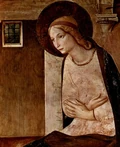
San Albino Church, Mesilla Village, Las Cruces, New Mexico (January, 1985).
Marian feast days are specific days of the year declared by the Catholic Church as being significant Marian days for the celebration of events in the life of the Blessed Virgin Mary and her veneration.[1]
During the month of May, May devotions to the Blessed Virgin Mary take place in many Catholic regions. There is no firm structure as to the content of a May devotion. It includes usually the singing of Marian anthems, readings from theScriptures, a sermon, and/or a presentation by local choirs. The whole rosary is prayed separately and is usually not a part of a Marian devotion, although Hail Mary's are included. The devotion, was promoted by the Jesuits and spread to Jesuit colleges and to the entire Latin Church and since that time it has been a regular feature of Catholic life.[2] Marian devotions may be held within the family, around a “May Altar” consisting of a table with a Marian picture decorated with many May flowers. The family would then pray together the rosary.[3] May devotions exist in the entire Latin church and since that time have been a regular feature of Catholic life.[4]
Traditionally, the month of October is "rosary month" in the Catholic Church, when the faithful are encouraged to pray the rosary if possible. Since 1571, Mary, Queen of the Holy Rosary, is venerated on October 7.[5] Pope Benedict XVI, following all his predecessors, also encourages the rosary during the month of October:
- The month of October is dedicated to the Holy Rosary, the unique contemplative prayer through which, guided by the Lord's Heavenly Mother, we fix our gaze on the face of the Redeemer in order to be conformed to his joyful, light-filled, sorrowful and glorious mysteries. This ancient prayer is having a providential revival, thanks also to the example and teaching of the beloved Pope John Paul II. I invite you to reread his Apostolic Letter Rosarium Virginis Mariae and to put into practice its directions on the personal, family and community levels.[6]

Marian art is at times used to reflect Marian feasts. This statue of Our Lady of Sorrows in the hermitage church of Warfhuizen, Holland, is dressed for the month of October.
Among the most prominent Marian feast days in the ordinary Roman Catholic Calendar are[7]:
- January 1 Mary, Mother of God
- January 8 Our Lady of Prompt Succor
- February 2 Purification of the Virgin
- February 11 Our Lady of Lourdes
- March 25 Annunciation by Archangel Gabriel (it may be either moved to the day before Palm Sunday should this date be on Holy Week; or to the Monday after the second Sunday of Easter if this date falls on either Friday or Saturday of Holy Week or during Easter Week[8])
- April 26 Our Lady of Good Counsel
- May 1 Queen of Heaven
- May 13 Our Lady of Fatima
- May 24 Mary Help of Christians
- May 31 Mary, Mediatrix of all Graces
- May 31 Visitation of the Blessed Virgin Mary
- June 27 Our Lady of Perpetual Help
- July 16 Our Lady of Mount Carmel
- August 15 Assumption into Heaven
- August 21 Our Lady of Knock
- August 22 Queenship of Mary
- September 8 Nativity (birth) of the Blessed Virgin Mary
- September 12 Most Holy Name of the Blessed Virgin Mary
- September 15 Our Lady of Sorrows
- October 7 Most Holy Rosary
- November 21 Presentation of Mary
- December 8 Immaculate Conception
- December 12 Our Lady of Guadalupe
|
Specific views |
| Key prayers & devotions |
|
Ecumenical |
In the extraordinary form of the Roman Rite, the Visitation is observed on July 2. Its modern date, May 31, is instead the Queenship of the Blessed Virgin Mary. The Immaculate Heart of Mary is commemorated on August 22 (which in the modern calendar is the Queenship). Friday in Passion Week (the week prior to Holy Week) is observed as the Seven Dolors of the Blessed Virgin Mary. The Feast of the Seven Sorrows of the Blessed Virgin Mary is celebrated on September 15, and the Motherhood of the BVM is October 11. The Solemnity of Mary, Mother of God, does not exist in the extraordinary calendar.
Among the most prominent Marian feast days in the Eastern Orthodox and Greek-Catholic liturgical calendars are:
- March 25 Annunciation of the Theotokos
- August 15 Dormition of the Theotokos
- September 8 Nativity of the Theotokos
- November 21 Entry of the Theotokos into the Temple
- December 26 Synaxis of the Theotokos
In most Anglican calendars, the following Marian feasts are observed:
- December 8 Conception of the Blessed Virgin Mary
- February 2 Presentation of the Lord
- March 25 Annunciation to the Blessed Virgin Mary
- May 31 Visitation of the Blessed Virgin Mary
- August 15 St Mary the Virgin/the Blessed Virgin Mary/the Falling Asleep of the Blessed Virgin Mary
- September 8 Nativity of the Blessed Virgin Mary
North American Lutheran calendars commemorate the Visitation on May 31 and "Mary, Mother of Our Lord" on August 15.
See also[]
- Mariology
- The Glories of Mary
References[]
- ↑ Mary - Marian Feast Days and Prayers
- ↑ www.catholicculture.org/liturgicalyear/prayers/view.cfm?id=758
- ↑ http://de.wikipedia.org/wiki/Maiandacht
- ↑ www.catholicculture.org/liturgicalyear/prayers/view.cfm?id=758 -
- ↑ www.wf-f.org/Rosary.html
- ↑ Angelus Message 10/2/05
- ↑ Memorials of the Blessed Virgin Mary
- ↑ Vatican changes dates for 2008 feasts of St. Joseph, Annunciation, Singapore Catholic News, 24 August 2006
